Installing an Outdoor Sink
Final Result
Tada! We use the little baskets for storing cutlery, and the counter is used for prep before using the grill. The bucket catches the water, but you could use a drain pipe.
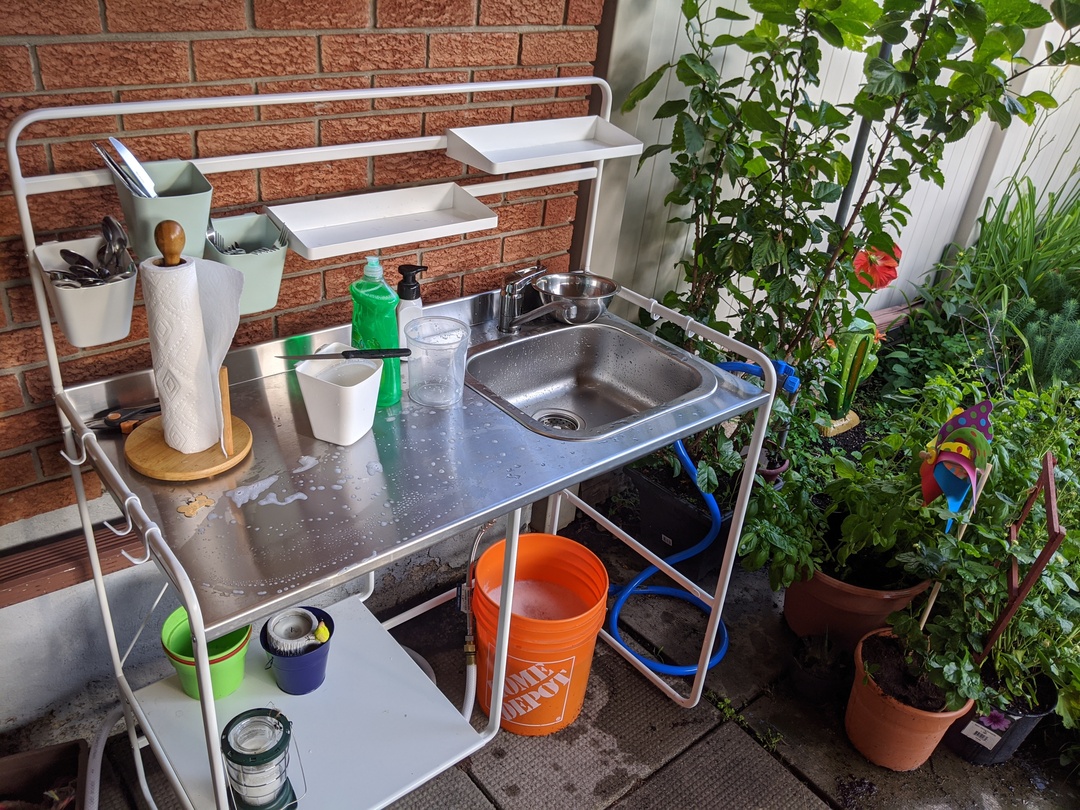
Outdoor sink installed
Initial Idea
With the pandemic in full swing, and my parents still wanting us to come by for outdoor dinners (as is permitted for us here in Ontario), I realized a really practical tool would be an outdoor sink. At this point we had been using a mix of hand sanitizer or soap while wrangling the garden hose. It works, but it leaves a mess (the hose is in a corner of the patio between two walls, with pavers below. All that water needs to go somewhere).
The intiial idea was to just buy a kit that Lee Valley sells: XB206 - Stainless-Steel Outdoor Wash Table. However like most of Lee Valley’s seasonal items, this sold out extremely quickly.
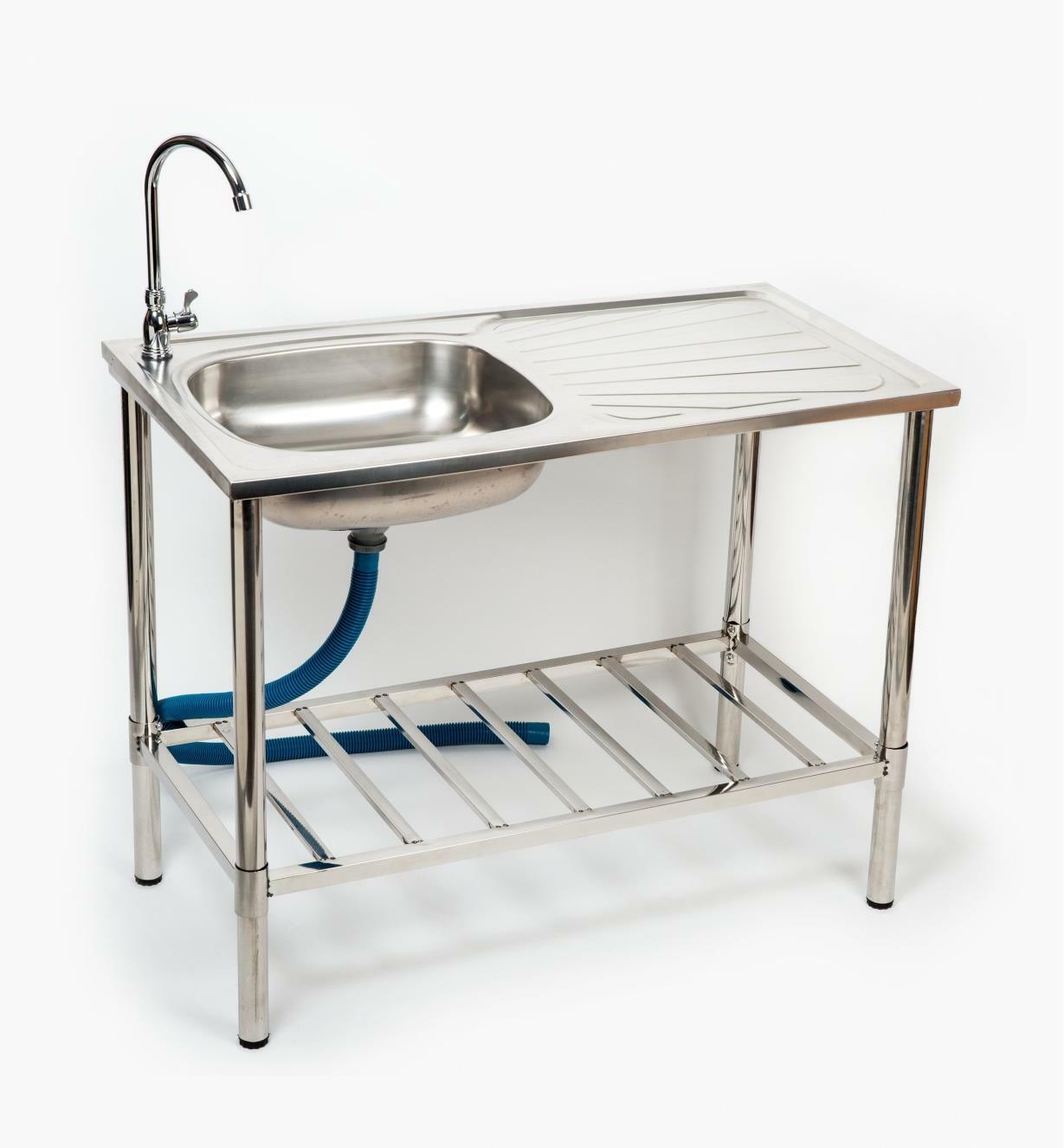
the original inspiration: lee valley xb206
I didn’t know that these things were common enough, sold under the name of “filleting station” or “fish gutting station”, often sold to people who go fishing at their cottages and want a place to process their fish. I did come across a lot of videos of people using laundry tubs, but in my own experience sometimes plastic outdoors is a little lacking. I was planning on going that route until I came across something… The IKEA SUNNERSTA
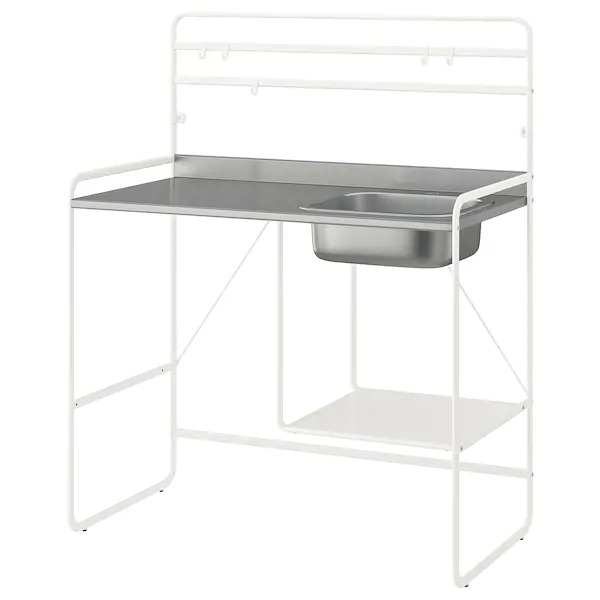
SUNNERSTA sink
This kitchenette is easy to put together, with a strainer and faucet would cost less than $200, and it’s all stainless or painted metal so it should survive outside (we have it under a covered awning). To help it out, we plan on covering it with a tarp over the winter (or disassembling it and bringing it in if necessary). Realistically it should do better than a plastic laundry tub – any other year it might be easier to find one of those for free, but we had to plan with what we could find. The only real advantage to using a laundry tub (being able to give a pet a bath) didn’t really apply to us. I can’t see any reason we’d want the deep basin out here, and this way we get a great counter and a handy shelf.
Limitations
I don’t have it set up for hot water, only cold. Finding some of these fittings can be a challenge. And draining it is a little bit of work, but you could set up a pipe to dump it in a garden. You’ll want to use a sink that is ok for outdoor use (the SUNNERSTA might not last long term). And finally make sure your fittings are lead-free safe unless you absolutely don’t care, or if you’re never going to drink water.
The Final Plan
With this kichenette in my head, I decided to put a plan into action: we’d buy the kitchenette, the cheapest faucet, and use a bucket for a drain. We’d let my mother dump the bucket when we left, and leave it attached to the tap using a splitter. With the help of a drinking-safe garden hose, we would ensure the water is safe to drink from.
We used an IKEA SUNDSVIK as our faucet (it was $39.99 + tax) – though again sometimes if you’re lucky you can find ones for free or basically free, or repurpose an older one. Ironically we donated our old one to Habitat for Humanity last year when we changed it for one with an integrated pullout hose.
For a spitter, our local Home Hardware sells plastic ones which I really recommend (brass fittings for garden hoses often aren’t lead-free, but the plastic ones are. Don’t use aluminium unless the whole system is aluminium).
For a drinking-safe hose, we used a Camco 1/2" ID Drinking Water Hose (the white ones with yellow ends). Unfortunately with garden hose equipment, again there’s no guarantee it’s lead free, but this is as close as we can get.
Now the more challenging part: connecting the faucet to the hose.
I bought all of my fittings at Home Depot. You should be able to find these at Rona and Lowes. I wasn’t able to find them in Home Hardware, and the ones at Canadian Tire weren’t marked as safe for drinking (or lead-free). If you’re international, you’re on your own, sorry.
Start with a 3/8 tee fitting, the one I used is the Sioux Chief 3/8 inch Compression Tee Lead Free Brass. You’ll connect both ends of the faucet to it (unless you have a way to supply hot water) (more on that later). This part cost me $5.70 + tax.
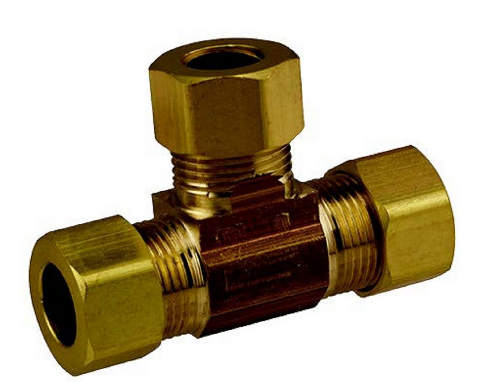
3/8 compression Tee fitting, lead-free brass, Sioux Chief brand
Next you’ll need a braided stainless steel hose – one that goes from 3/8 compression to 1/2 FIP (the typical one for indoor plumbing thread). I used the Aqua-Dynamic Flex Connector Stainless Steel 3/8" Compression X 1/2" FIP X 20" Faucet Lead Free.
Finally you’ll need some way to convert that to a garden hose, and this part took three trips to Home Depot to figure out (unfortunately Home Depot was the only hardware store in my area that sold these fittings in brass and lead-free). You want something like this: Sioux Chief 3/4 inch x 1/2 inch Lead-Free Brass FGH x MIP Adapter. The key is the 3/4 FGH to 1/2 MIP: FGH is female garden hose, MIP is male imperial thread. This is actually easy to connect – thread onto the garden hose first, and then connect the stainless steel braided hose fitting (as that one is meant to rotate onto a fitting on through a wall/floor).
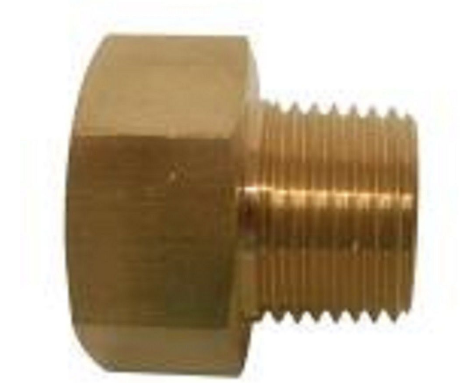
3/4 Female Garden Hose to 1/2 Male Imperial Thread, lead-free brass, Sioux Chief brand
Oddly enough, the IKEA manual says to use a 9/16" hose fitting, but I have no idea what that is. 3/8 worked fine. You might need to get a compression fitting to get this work, but in my case I didn’t need anything.
I found all these fittings came together perfectly without leaking, but you might need thread tape. The initial plan pitched to me by the Home Depot plumber involved a galvanized steel nipple… Later I replaced it with a brass nipple before realizing I could go from FGH to MIP, not just FGH to FIP.
Hot Water
Unfortunately this doesn’t supply hot water. Getting hot water is even simpler though since you don’t need the 3/8 compression T, just two FGH x MIP adapters and two braided stainless steel hoses. In Canada it’s not common to have an outdoor silcock with hot water, so we have to work with the one cold water hookup. You can however use a solar heater, or even coil a dark-coloured hose in a sunny spot to get some hot water. In our case it just wasn’t worth the amount of work needed.